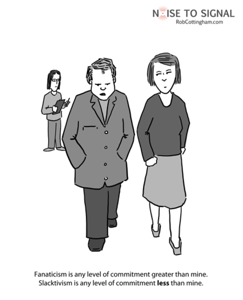The #stopkony phenomenon of that last week has triggered a passionate debate over philanthropy and advocacy – from whether “awareness-raising” is a useful goal or one that saps energy and attention from the harder but more important work of building lasting change; to whether steering scarce resources and attention to arresting one man is a good idea; to how Western charities and their supporters can support positive change in countries like Uganda without engaging in a kind of western-savior cultural and political imperialism.

But along with that conversation, there’s also been some disdain for the thousands of thousands of young people who were moved to participate for the first time on any issue, let alone an international one. “Slacktivism” is the insult of choice. And the risk is that drowning their enthusiasm in derision will turn them off activism altogether. Or it may further alienate them from the organizations and approaches that are building lasting, long-term progress on self-determination, self-reliance and social justice – the kind that takes the big picture into mind.
Can those organizations learn from Invisible Children’s viral success? That would be ideal – but it’s not like they can treat the approach as a template. Global Voices co-founder Ethan Zuckerman says it well:
The Kony story resonates because it’s the story of an identifible individual doing bodily harm to children. It’s a story with a simple solution, and it plays into existing narratives about the ungovernability of Africa, the power of US military and the need to bring hidden conflict to light…. What are the unintended consequences of the Invisible Children narrative? The main one is increased support for Yoweri Museveni, the dictatorial and kleptocratic leader of Uganda….
As someone who believes that the ability to create and share media is an important form of power, the Invisible Children story presents a difficult paradox. If we want people to pay attention to the issues we care about, do we need to oversimplify them? And if we do, do our simplistic framings do more unintentional harm than intentional good? Or is the wave of pushback against this campaign from Invisible Children evidence that we’re learning to read and write complex narratives online, and that a college student with doubts about a campaign’s value and validity can find an audience? Will Invisible Children’s campaign continue unchanged, or will it engage with critics and design a more complex and nuanced response?
In the changing world of volunteer activism – particularly with the rise of social networks – non-profits are finding they have to change too, often fundamentally. That’s one of the key insights of Beth Kanter and Allison Fine’s book The Networked Nonprofit, which argues organizations have to become more open, and engage with their supporters more as peers and free agents than as volunteers slotted into pre-defined roles.
Harnessing the energy of a #kony2012 – and ensuring it does more good than harm – is one more challenge they’re facing.
See the complete archive Noise to Signal cartoons here. Creative-Commonsified for your sharing pleasure.


















